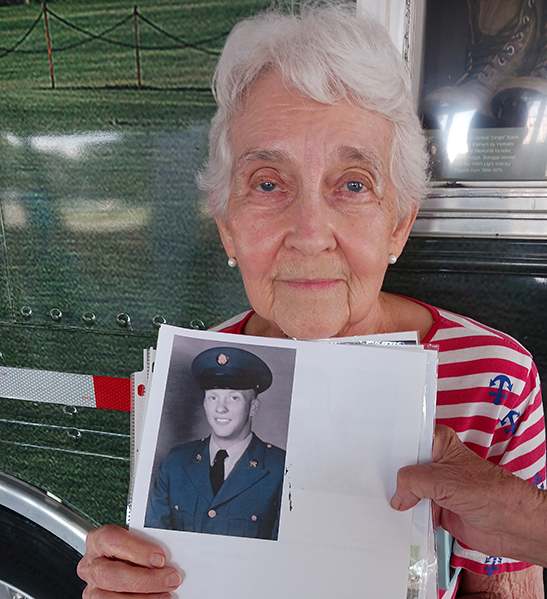Welcome!

Martha Watson holds a photo of her brother, Ronnie Trogdon, their first Randolph County casualty in the Vietnam War. Larry Penkava/Randolph Hub
Some wounds never heal
ASHEBORO — “It was agonizing. It still is.”
Even after 57 years, Martha Watson mourns the death of her brother, Ronnie Trogdon. He was killed on June 19, 1967, on a medevac helicopter mission in Vietnam.
Ronnie was the first person from Randolph County to die in the war and the first on his medevac crew. In fact, he wasn’t scheduled to go out that day but another crew needed help and he volunteered.
Ronnie grew up in Asheboro, one of six brothers and two sisters. He attended Asheboro High School, graduating in 1965.
“I went to school with him from ’63 to ’65,” Peggy Coble Cox said. “We graduated together. He was always a really nice guy and polite.”
Cox had gone to see The Wall that Heals exhibit, a three-quarter scale replica of the Vietnam Veterans Memorial in Washington, DC, at South Asheboro Middle School. The exhibit was in Asheboro from June 18-23, the only North Carolina stop on a nationwide tour.
The Wall has the names of 58,281 men and women who died during the Vietnam War. Ronnie Trogdon is one of those names.
Watson said he knew how to work on helicopters and could even fly one when necessary. He became crew chief of a medevac that he chose to christen Old Reliable because it faced lots of fire but always came back home.
His crew was part of the First Air Cavalry Division and their job was to fly out and rescue wounded soldiers.
Watson said her brother began working at Cummins Frozen Foods while still in school and continued full-time after he graduated. He was drafted in 1966 when he was 19, went to boot camp and then to helicopter training in Virginia.
During a visit with Ronnie, Martha said, he told them, “You know we’re going to Vietnam.”
On that day — June 19 — Ronnie took off with another crew to pick up some wounded. During the rescue, the helicopter received enemy fire.
Ronnie returned fire to protect his crew members. Even after being wounded himself, he continued firing until the medevac took off.
He died that day in an evacuation hospital. He was 90 days from coming home.
“It was on Thursday evening, the 23rd, and we were making ice cream,” Watson said. “I stepped across a branch during a walk and thought, ‘Ronnie’s not going to need ice cream any more.’ I felt that all that day.”
She said she had gone to bed that night when her sister, Nancy, called and said to “get up here. The Army had knocked on the door.”
All the brothers were called in as well and they were told that the officers “had information he had died. The next day we got a telegram and his last letter. In it he said, ‘I’ll see you in 90 days.’ It was dated June 17. It was agonizing and it still is.”
Watson said her parents and sister were able to talk to Ronnie about a month before he died. “I’m glad they got to.”
Ever since, Watson has kept photos, newspaper articles and other mementoes about Ronnie. She has made sure her grandchildren know about their great-uncle and his sacrifice for his country. His medals include the Purple Heart, the Distinguished Flying Cross, the Bronze Star, the Gallantry Cross with Palms and the Merit Award from the Vietnamese government.
Years later, the Trogdon family learned that Old Reliable had been found in a field in New York State. It’s been restored and moved to the National Huey Museum in Peru, Indiana.
Watson said some of the family members went to see the helicopter Ronnie flew in and they even took flights in it. She said she couldn’t muster the courage to go.
She remembers her brother being “easygoing, always happy. He loved the outdoors and had a horse named Dynamite.”
Watson said she often sees old friends of Ronnie’s, many of them with all sorts of health problems, showing the ravages of age. “Sometimes I think he was the lucky one.”
Ronnie is buried in Oaklawn Cemetery, within shouting distance of the site where The Wall That Heals was displayed.
More information can be found at www.thewallthatheals.org.
